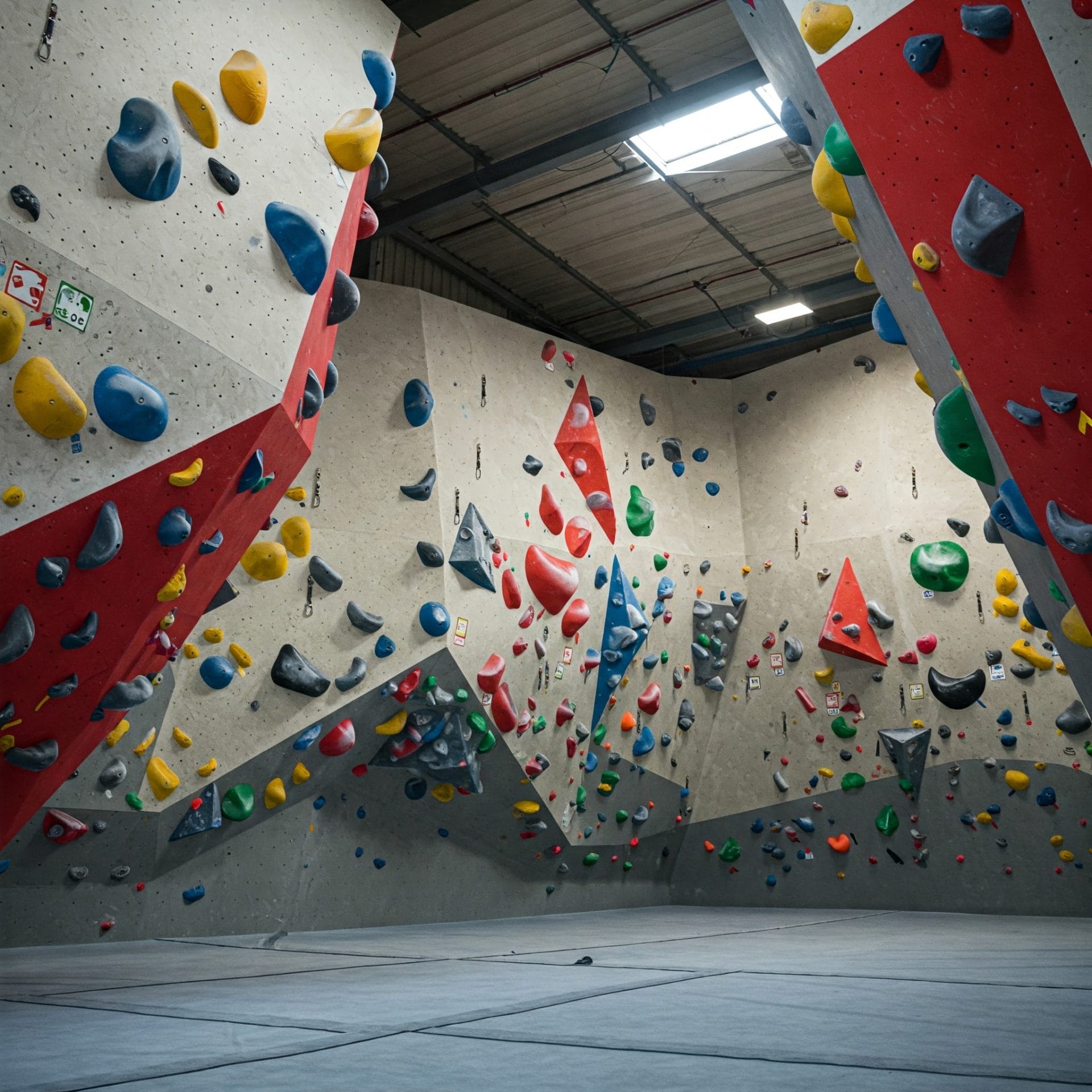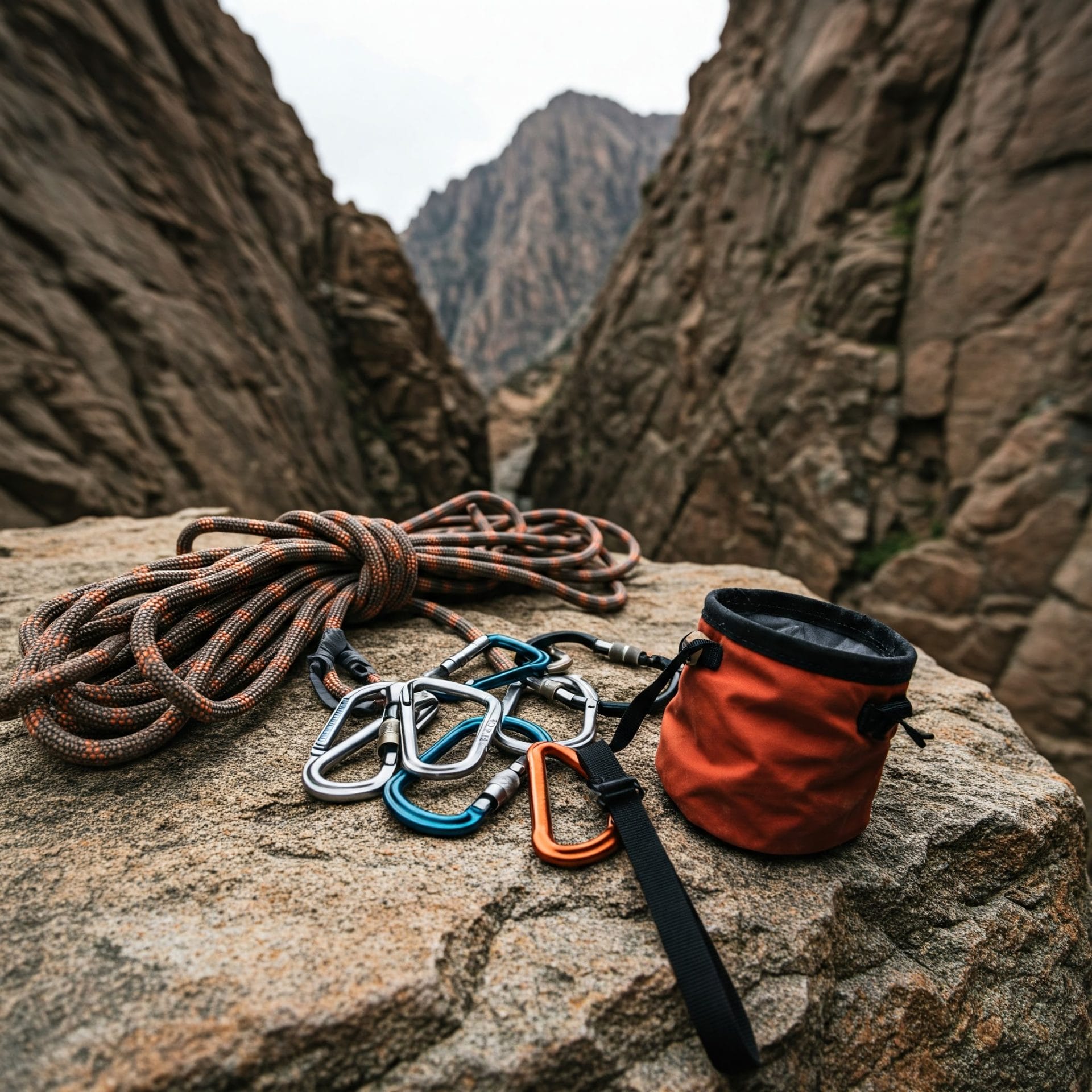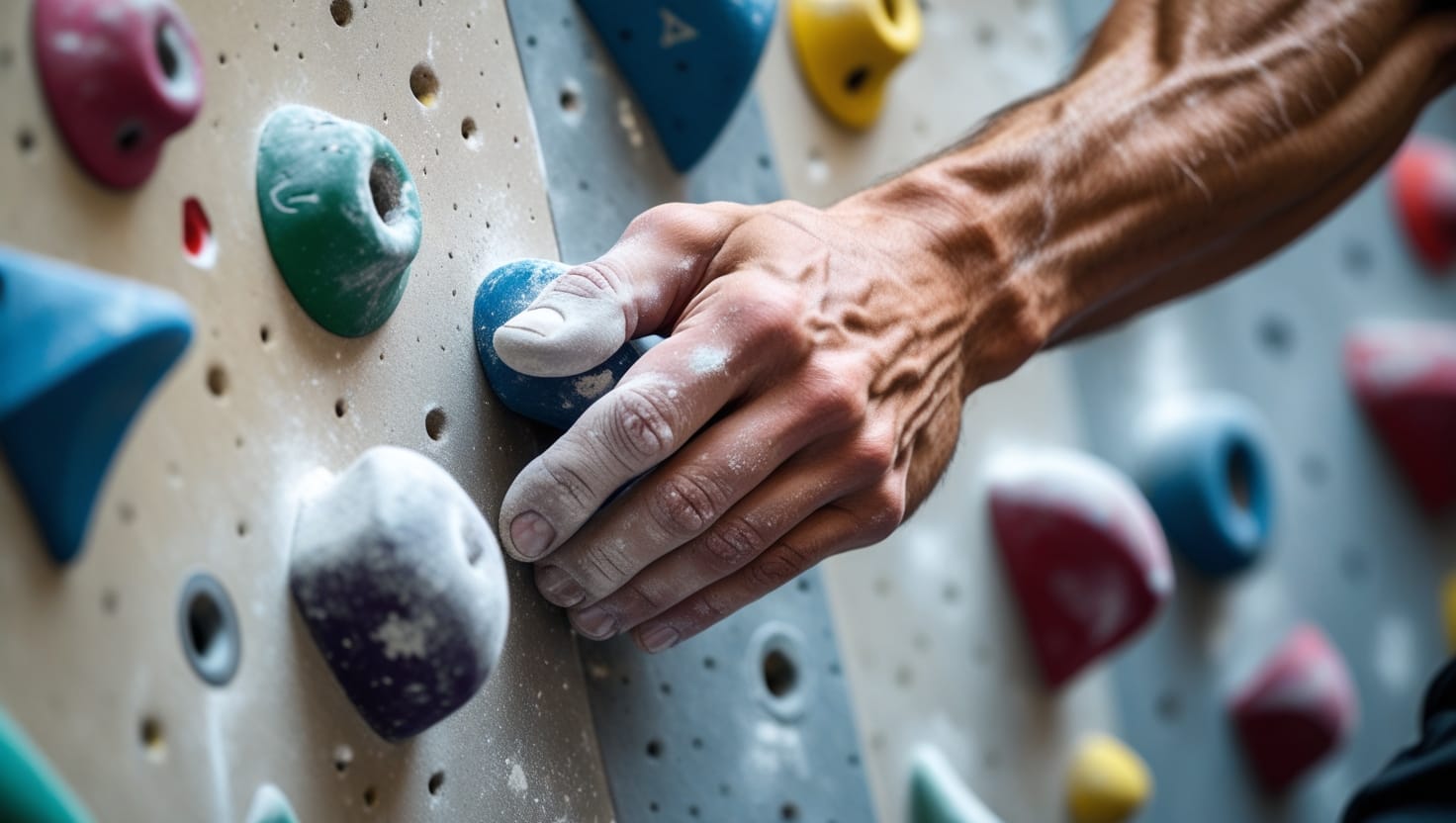This article explains important bouldering terms that help climbers understand the sport better. Learn the words that matter!
Technical terms fill the bouldering world, creating a language unique to climbers at the gym or crag. Words like “beta” (climbing sequence), “dyno” (dynamic jump move), and “crimp” (gripping tiny holds) flow through conversations near the chalk-dusted walls. These terms, while puzzling at first, serve as essential building blocks for understanding climbing movements and techniques. (1)
From “jugs” (large positive holds) to “slopers” (rounded holds), each word describes specific features or movements that climbers encounter. Learning this vocabulary opens doors to better communication and progression in the sport.
Key Takeaway
- Bouldering has its own special vocabulary.
- Knowing climbing terms helps with safety and communication.
- Learning about holds and techniques can make climbing more fun!
Climbing Techniques
Credit:By Lattice Training
- Arete: A sharp, narrow ridge formed where two rock faces meet, requiring balance and focus. Climbers use their feet, legs, core, and arms to maintain stability, avoiding excessive reliance on hands.(2)
- Dyno: A dynamic movement involving a leap to an out-of-reach hold. It demands power, coordination, and a controlled landing. A climber must commit fully and land with precision, keeping the body in sync.
- Mantle: The move to pull oneself over a ledge. It involves pushing with arms and using legs for support. Strength and mental focus are crucial to completing the move.
- Heel Hook: A technique where the heel is used to stabilize and balance. Proper pressure and control of body position are essential to avoid losing balance or tension.
- Toe Hook: A move where the toe hooks over a hold to stabilize the body. It requires strength, flexibility, and timing to maintain balance.
- Drop Knee: A body movement that twists the knee downward, creating an angle for better reach and balance. It saves energy and helps with higher holds.
Holds and Grips
Crimp:
- Size: Few inches long, less than a centimeter wide.
- Grip: Fingers bend and lock, using only fingertips.
- Strength needed: High strain on fingers and tendons.
- Caution: Ease into the grip to avoid tendon strain.
- Workout: Primarily a finger workout, focusing on fingertip strength.
Jug:
- Size: At least hand-sized, sometimes bigger.
- Grip: Open grip with fingers wrapped, little tension.
- Rest: Can be deceptive—don’t get too comfortable.
- Function: Provides a chance to rest but requires focus.
Sloper:
- Shape: Round, smooth, and slippery.
- Grip: No traditional grip; press into it with body.
- Tension: Requires core engagement and balance.
Pocket:
- Size: Fits fingers or toes, deep enough for a partial grip.
- Grip: Finger lock or palm press.
- Function: Provides a brief secure hold for movement.
Pinch:
- Grip: Squeeze between thumb and fingers.
- Size: Varies, but usually enough to wrap around.
- Function: Squeeze tightly while maintaining balance.
Equipment
Bouldering Pad
- When you enter a bouldering gym, the sea of foam pads is immediately noticeable.
- These pads are crucial for safety, absorbing the impact of falls to prevent injury.
- Most pads are around 4 inches thick, with some thicker options for high-ball bouldering.
- The foam is dense yet soft, cushioning your fall.
- Bouldering pads come in various shapes, including rectangular, corner, and full pads.
- Durable, weather-resistant fabric covers the foam, protecting it from dirt and the elements.
- For climbers who explore outdoor spots, sturdy straps and handles make the pads easy to carry.
Climbing Shoes
- Climbing shoes are essential for proper foot placement and grip on the wall.
- They fit tightly, almost like a second skin, to maximize contact with holds.
- Rubber soles are key—softer rubber offers more grip but wears faster, while harder rubber lasts longer but offers less friction.
- Beginners should consider neutral shoes for comfort, while advanced climbers may prefer more aggressive shoes for better performance.
- Proper fit is vital—too tight causes blisters, too loose reduces precision.
Climbing Routes and Problems
Climbing is like solving a puzzle with your body. You figure out where to place your feet, how to grip without burning out, and what to do next when the rock doesn’t cooperate.
Climbing involves:
- Precision: Small holds require careful body movements.
- Leg strength: For vertical faces, your legs do more work than your arms.
- Skill-building: Like learning a new language, climbing helps you use your body efficiently.
Grades help gauge difficulty:
- 5.0 is easy, while 5.15 is extreme.
- Grades are subjective, depending on factors like height, experience, and weather.
- They serve as a guideline but aren’t a guarantee of success.
The crux is the hardest part of the climb.
- It’s like the final boss of a video game.
- It’s where you face mental and physical challenges.
- Push through the crux, and the rest of the climb gets easier.
Safety and Spotting
Spotting: The Safety Net for Every Climber
- Spotting is crucial for climbers, emphasizing trust in both your skills and the spotter’s awareness.
- A good spotter stays close but not too close, positioning themselves to catch a fall if needed.
- Spotting isn’t about catching mid-air; it’s about anticipation and readiness.
- Keep your eyes on the climber, aware of when they start losing balance.
- Comfort is key: make sure the climber feels mentally and physically supported.
- Spotting prevents serious injuries, especially with high bouldering walls.
- Timing and positioning are vital for providing the best support.
Top Out: The Climber’s Victory Dance
- The top out is a moment of triumph after conquering a boulder.
- Precision, strength, and technique are needed to make it over the lip.
- Focus on balance and body position as you reach the top.
- Don’t rush after reaching the top; celebrate the accomplishment.
- The top out is a reminder of what you can achieve despite doubts.
Miscellaneous Terms
Bulge: A Rock’s Belly
- A bulge is an overhanging part of the rock that sticks out.
- It makes climbing more difficult, forcing you to find creative solutions.
- You might have to pull yourself up awkwardly or shuffle around it.
- It challenges your technique and forces you to use your whole body.
- Climbing a bulge is a mental and physical puzzle.
Traverse: The Sideways Climb
- A traverse is a horizontal climb, moving sideways across the rock.
- You balance your body differently, with no rope to catch you if you fall.
- It’s about precision: every hand and foot placement matters.
- Traversing is slower, requiring patience and focus on balance.
Highball: The Tall Boulder
- A highball is a tall bouldering problem, over 15 feet high.
- Without a rope, it’s all about mental toughness and precision.
- A fall can be harsh, so technique and calm are essential.
- The rush of reaching the top makes the climb worth it.
Conclusion
Bouldering vocabulary forms a critical base for any climber’s success on the rock. These technical terms help climbers communicate effectively about routes, techniques, and safety measures. From beta to crimps, each word serves a specific purpose in describing movements and holds. Understanding these terms doesn’t just build knowledge – it creates safer climbing experiences. Mastering this vocabulary opens doors to better communication within the climbing community.
FAQ
What is a beta when people talk about climbing a route?
Think of beta as your game plan for conquering a climb. It’s the sequence of moves you’ll use to get from the bottom to the top. When climbers share beta, they’re basically giving you their cheat code – like “reach left hand to that crimp, then match feet on the volume.” Everyone might have slightly different beta since we all climb differently. Sometimes you might hear “flash beta,” which means getting route tips before you try it for the first time.
What does it mean when climbers say “Send”?
“Send” is just climber-speak for successfully completing a route without falling or hanging on the rope. If you hear someone yell “Send it!” they’re cheering you on to finish the climb. When you tell your friends “I sent that blue V4,” you’re saying you made it to the top without any falls. The term probably came from “ascend,” but now it’s just part of everyday climbing lingo.
What’s the difference between a crimp and a pinch?
A crimp is when you grab a thin edge with your fingers bent and your knuckles pointing up – imagine holding onto the spine of a book on a shelf. A pinch is exactly what it sounds like: you squeeze the hold between your thumb and fingers, like gripping a thick sandwich. While crimps are usually on flat edges, pinches stick out from the wall and need that opposing thumb pressure to use effectively.
What do V0, V1, V2, etc. mean in bouldering?
These numbers are part of the “V scale,” a way to grade how difficult boulder problems are. V0 is where most beginners start, and the numbers go up as climbs get harder. Each grade represents a significant jump in difficulty. V0-V2 are typically considered beginner-friendly, V3-V5 intermediate, and V6+ advanced. But remember, these grades are subjective – what feels like a V2 at one gym might feel like a V3 at another.
What’s a spotter, and why do I need one?
A spotter is your safety buddy who helps guide your fall onto the crash pad if you come off the wall. They don’t try to catch you – instead, they keep your head and spine from hitting the ground or pad edges by guiding your fall to land feet-first. Spotting is super important when bouldering outdoors or on overhanging problems where you might fall away from the wall.
What does “flash” mean in bouldering?
Flashing a route means completing it perfectly on your very first try. The catch is that you’re allowed to get beta (advice) from other climbers or watch someone else climb it first. It’s different from an “onsight,” where you climb it first try without any prior information. Flashing a route is pretty impressive since you need to execute everything perfectly without having tested the moves yourself.
What’s a gaston, and how do I do it?
A gaston is a move where you grip a hold with your thumb pointing down and elbow pointing out – kind of like opening heavy doors. You’re pushing outward instead of pulling down, which makes it feel pretty counterintuitive at first. The name comes from French climber Gaston Rébuffat. You’ll often use gastons when the usual pull-down grip just isn’t possible, like on opposing holds or certain arêtes.
What’s the difference between slopers and jugs?
Jugs are the friendly holds that feel like handles – you can wrap your whole hand around them for a solid grip. Slopers, on the other hand, are those smooth, rounded holds that feel like trying to grab a basketball. They rely more on friction and body positioning than pure grip strength. The key to slopers is keeping your weight directly under them and using as much surface contact as possible.
References
- https://www.climbing.com/news/rock-climbing-terms-definitions/
- https://www.devilslakeclimbingguides.com/blog/climbing-terms-for-beginners?srsltid=AfmBOop3Oi0RTX2xeeK0F2eGmxjkUYUxbEXhxrtVM7yE9p3wI7BS0X5Y






